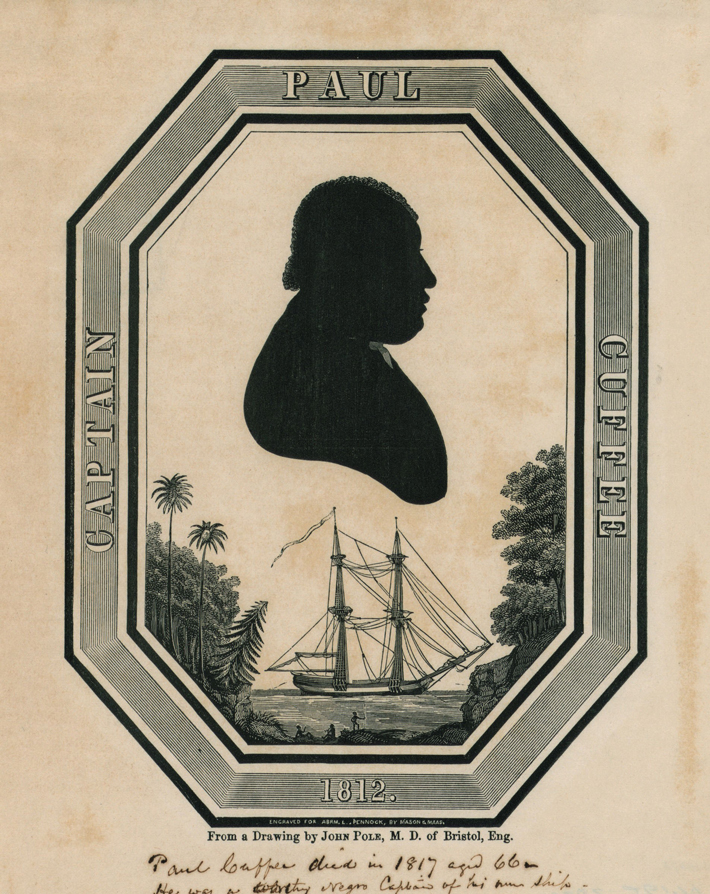 Among African Americans and Native Americans involved in the whaling industry, the most prominent was Paul Cuffe. Cuffe was born in 1759 on Cuttyhunk Island, around 10 miles south of Westport, Massachusetts, to Cuffe Slocum, a formerly enslaved man who had purchased his own freedom, and Ruth Moses, a Wampanoag woman. The family moved to a 116-acre Westport farm in 1767, and Cuffe began his maritime career as a teenager, signing on to a whaleship as a novice. During a subsequent whaling expedition, in 1776, he was taken prisoner by the British Royal Navy and jailed in New York Harbor for three months. Upon his release, Cuffe spent the rest of the Revolutionary War evading a British blockade to ferry supplies by night to Nantucket Island.
Among African Americans and Native Americans involved in the whaling industry, the most prominent was Paul Cuffe. Cuffe was born in 1759 on Cuttyhunk Island, around 10 miles south of Westport, Massachusetts, to Cuffe Slocum, a formerly enslaved man who had purchased his own freedom, and Ruth Moses, a Wampanoag woman. The family moved to a 116-acre Westport farm in 1767, and Cuffe began his maritime career as a teenager, signing on to a whaleship as a novice. During a subsequent whaling expedition, in 1776, he was taken prisoner by the British Royal Navy and jailed in New York Harbor for three months. Upon his release, Cuffe spent the rest of the Revolutionary War evading a British blockade to ferry supplies by night to Nantucket Island.
At the end of the war, Cuffe began assembling a fleet of ships that he used for whaling, fishing, and shipping. Cuffe himself, or his relatives, captained many of these vessels, and they tended to have all-Black crews. “It was unusual for a Black man to own ships,” says Lee Blake, president of the New Bedford Historical Society and a descendant of Cuffe. “Paul hired men of color who were family members and friends—in that sense, it wasn’t unusual as that is also what white ship captains did.” He developed strong relationships with leading Quaker businessmen, eventually joining the Westport Friends Meeting, and became one of the wealthiest and best-known African Americans in the United States. A dedicated abolitionist, Cuffe was active in efforts to create a settlement for freed slaves in West Africa. When he returned to Westport from a fact-finding mission to the British colony of Sierra Leone just before the start of the War of 1812, his cargo was deemed illegal due to rising tensions with England and his ship impounded by U.S. customs officials. Cuffe attained an audience with President James Madison—perhaps the first African American to have an official meeting with a U.S. president—as well as the secretary of the treasury, who ordered his ship released.
Among Cuffe’s business partners were Isaac Cory Sr. and Isaac Cory Jr., the owners of Industry. In 1802, Cuffe and the Corys built Hero, a two-masted, 75-foot-long vessel, in Cuffe’s Westport shipyard. Originally intended for the merchant service, the ship was later outfitted with a third mast and put to use as a whaling bark. In September 1810, Cuffe and the Corys sent Hero on a two-year whaling mission around Cape Horn. It did not go well. On June 30, 1812, the ship’s captain wrote from Coquimbo, Chile, to share a tale of woe including crew members stricken with scurvy, poor weather, and rotted timbers on the ship, which was ultimately condemned. Nonetheless, the captain managed to send back nearly 700 barrels of sperm whale oil on other ships. Cuffe died in 1817 at the age of 58, but his family’s connection to the Corys continued. Cuffe’s son-in-law, Pardon Cook, who would go on to make 11 whaling voyages in all, was a second mate on Industry in 1819 and 1821. And Cuffe’s youngest son, William, sailed on Industry in 1828 and 1832. Neither, however, was aboard the brig during its fateful final voyage.
|
Article: |

1,000 Fathoms Down |